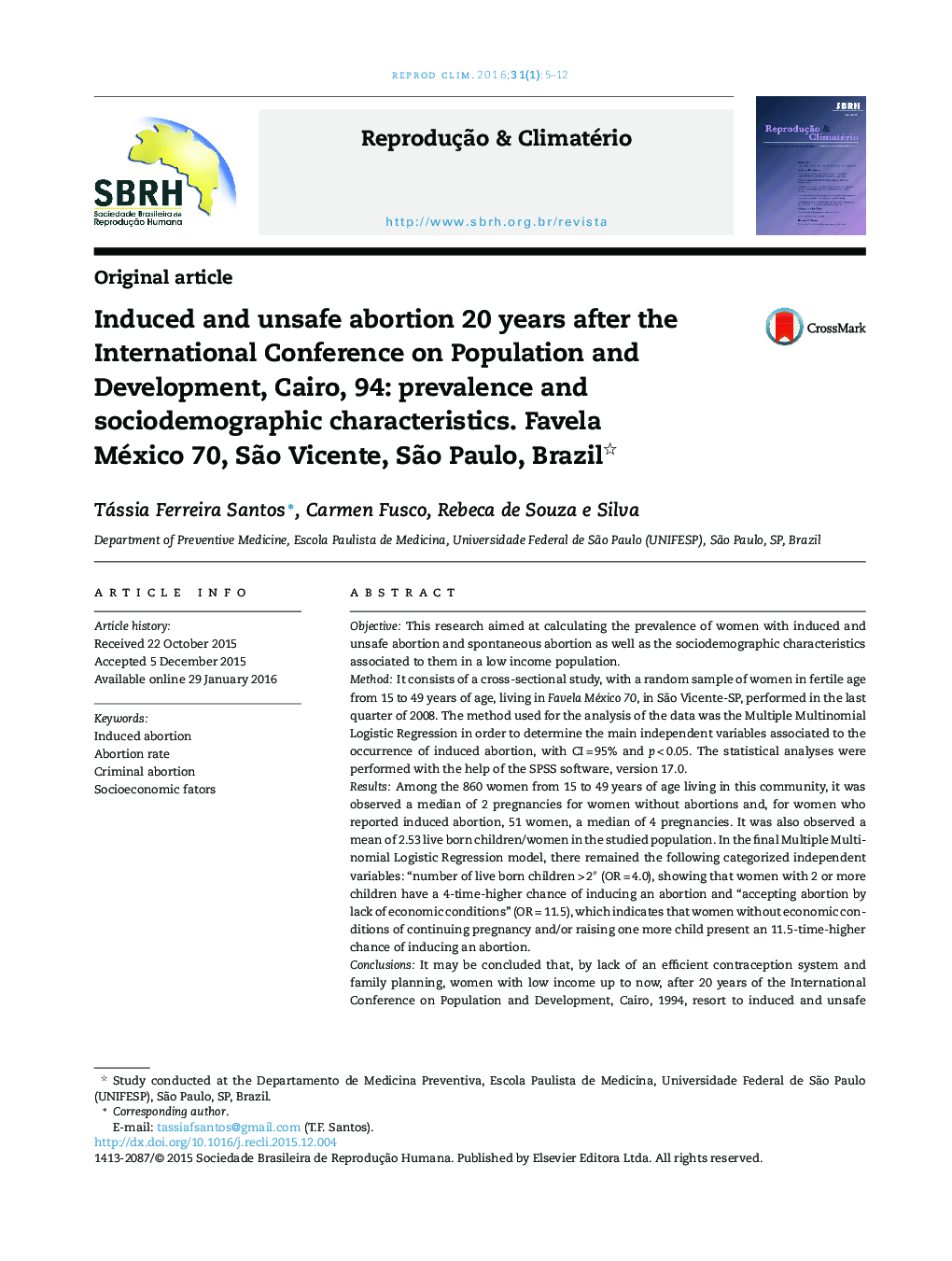| کد مقاله | کد نشریه | سال انتشار | مقاله انگلیسی | نسخه تمام متن |
|---|---|---|---|---|
| 3969817 | 1600894 | 2016 | 8 صفحه PDF | دانلود رایگان |
ObjectiveThis research aimed at calculating the prevalence of women with induced and unsafe abortion and spontaneous abortion as well as the sociodemographic characteristics associated to them in a low income population.MethodIt consists of a cross-sectional study, with a random sample of women in fertile age from 15 to 49 years of age, living in Favela México 70, in São Vicente-SP, performed in the last quarter of 2008. The method used for the analysis of the data was the Multiple Multinomial Logistic Regression in order to determine the main independent variables associated to the occurrence of induced abortion, with CI = 95% and p < 0.05. The statistical analyses were performed with the help of the SPSS software, version 17.0.ResultsAmong the 860 women from 15 to 49 years of age living in this community, it was observed a median of 2 pregnancies for women without abortions and, for women who reported induced abortion, 51 women, a median of 4 pregnancies. It was also observed a mean of 2.53 live born children/women in the studied population. In the final Multiple Multinomial Logistic Regression model, there remained the following categorized independent variables: “number of live born children > 2″ (OR = 4.0), showing that women with 2 or more children have a 4-time-higher chance of inducing an abortion and “accepting abortion by lack of economic conditions” (OR = 11.5), which indicates that women without economic conditions of continuing pregnancy and/or raising one more child present an 11.5-time-higher chance of inducing an abortion.ConclusionsIt may be concluded that, by lack of an efficient contraception system and family planning, women with low income up to now, after 20 years of the International Conference on Population and Development, Cairo, 1994, resort to induced and unsafe abortion in order to diminish their own fertility and family size, in face of an unintended, unwanted or inopportune pregnancy.
ResumoObjetivoCalcular a prevalência de mulheres com aborto provocado e inseguro e de aborto espontâneo, bem como as características sociodemográficas a eles associadas em uma população de baixa renda.MétodoEstudo transversal, com amostra aleatória de mulheres em idade fértil de 15 a 49 anos, residentes na Favela México 70, em São Vicente (SP), efetuada no último trimestre de 2008. O método usado para a análise dos dados foi a regressão logística multinomial múltipla para determinar as principais variáveis independentes associadas à ocorrência de aborto provocado, com IC = 95% e p < 0,05. As análises estatísticas foram feitas com o auxílio do programa SPSS versão 17.0.ResultadosEntre as 860 mulheres de 15 a 49 anos residentes nessa comunidade observou-se mediana de duas gestações para as sem aborto. Para as que declararam aborto provocado, 51, uma mediana de quatro gestações. Foi observada ainda média de 2,53 filhos nascidos vivos/mulher na população em estudo. No modelo final de regressão logística multinomial múltipla permaneceram as seguintes variáveis independentes categorizadas: “número de filhos nascidos vivos > 2″ (OR = 4,0), mostra que as mulheres com dois ou mais filhos apresentam uma chance quatro vezes maior de provocar um aborto; e “aceitação do aborto por falta de condições econômicas” (OR = 11,5), indica que as mulheres sem condições econômicas de prosseguir na gestação e/ou criar mais um filho apresentam chance 11,5 vezes maior de provocar um aborto.ConclusõesPor falta de um sistema eficaz de contracepção e de planejamento familiar, mulheres de baixa renda ainda hoje, após 20 anos da International Conference on Population and Development, Cairo, 1994, recorrem ao aborto provocado e inseguro para a diminuição da própria fecundidade e do tamanho da família, frente a uma gestação inesperada, não pretendida ou inoportuna.
Journal: Reprodução & Climatério - Volume 31, Issue 1, January–April 2016, Pages 5–12
